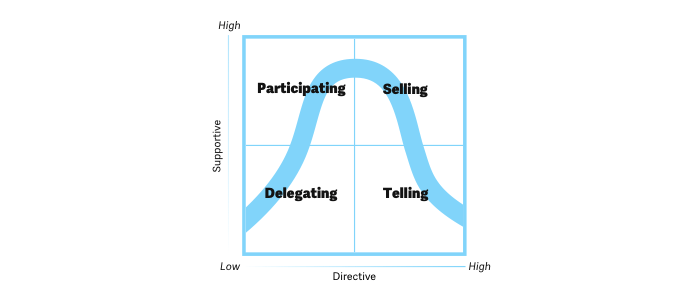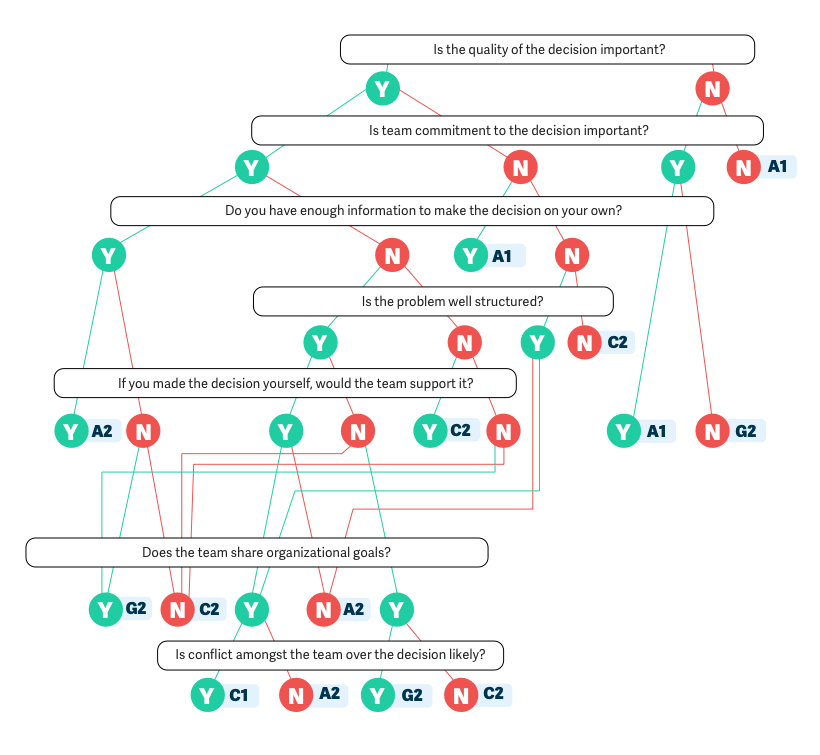You have 15 minutes at your disposal and want to know the basics of all leadership theories? This is THE post for you! It will provide you with essential information about all theories, the main idea behind each one, and a bunch of excellent links if you would like to further your research. So let’s get started.
GREAT MAN THEORY
The idea: Individual is born with characteristics of a leader.
According to this theory, an individual cannot become nor learn how to be a leader - leaders are simply born that way. This means that you either ARE or AREN’T a leader. Factors such as your upbringing, education, and experience are only shaping your leadership abilities - they aren't responsible for making you a leader.
This early theory of leadership studied the traits of great leaders such as Gandhi, Lincoln, and Napoleon, and even though it had no scientific validity, it was important as the starting point for the understanding which human traits make great leaders.
At the time it was all about having a dominant personality, charm, courage, intelligence, persuasiveness, and aggressiveness - in one word, being “charismatic”.
TRAIT THEORY
The idea: All leaders share common characteristics or "Traits”.
This theory focused on analyzing combinations of individual’s mental, physical and social characteristics, with the goal to determine if leaders share certain combinations.
Ambition and energy, honesty and integrity, self-confidence, intelligence, desire to lead, and job-relevant knowledge were all quite common among potential leaders. However, it turned out that none of these traits, nor any particular combination of them, can guarantee that a leader will be successful.
The developer of the Trait theory was Ralph Stogdill. In his Handbook of Leadership(1974) he determined which traits and skills differentiate leaders from non-leaders.

However, all of this turned out to be nothing more than a theory. Over the years, scientists have been trying to determine which specific characteristics make a leader. Unfortunately, all of them failed to provide us with any viable results.
BEHAVIOURAL THEORIES
The idea: Person's actions, not personal characteristics, determine if someone is a leader.
Unlike Trait theory, which focuses on what leaders are like, Behavioral theories try to focus on what leaders DO. This new perspective made it possible for someone without necessary traits to become a leader simply by acting like one. In other words, the Behavioral theory claims that leaders are made and developed, not born.
Lewin’s Framework
The idea: Leader needs to know when to adapt a particular behavior.
According to Kurt Lewin’s research, conducted in the 1930s, there are three types of leaders:
- Autocratic leaders: they make decisions without consulting their team.
- Democratic leaders: they allow the team to provide input before deciding.
- Laissez-faire leaders: they don't interfere with team dynamics, and they allow members to make many decisions.
Even though many leaders usually belong to a certain type, Lewin claims that the very best leaders have an ability to adapt: they can use many different behavioral styles and choose the right style depending on the situation.
Michigan Leadership Studies
The idea: Employee-oriented leadership approach is better than production-oriented approach.
This study identified two broad leadership styles: Employee-oriented style (which focuses on interpersonal relations and needs of employees, and accepts individual differences), and production-oriented style (which focuses on technical aspects of the job and accomplishing group goals, and regards workers as a means to an end).
Also, this study determined the three critical characteristics of an effective leader:
- Relationship-oriented behavior - effective leaders focused on the relationships with their subordinates and preferred a hands-off supervision rather than close control.
- Task-oriented behavior - effective leaders carefully planned out the work, and delegated tasks with challenging and achievable goals.
- Participative leadership - effective leaders strive to build a cohesive well-knit team, rather than work with a set of individuals.
Finally, studies concluded that an employee-oriented leadership rather than the production-oriented, coupled with general instead of close supervision, led to better results.
Ohio University Leadership Studies (Leadership Grid)
The idea: Leader must pay equal attention to both people and results
The model identified five leadership styles by their relative positions on the Leadership grid. Previously known as the Managerial Grid, it relies on two behavioral dimensions - concern for production and concern for people.

- Impoverished style (1,1): The leader is unconcerned for employee satisfaction and work deadlines. As a result productivity and satisfaction within the organization drops.
- Produce or perish style (9,1): The leader believes that efficiency is achieved through proper process organization and elimination of human factor wherever possible. This style increases the output in short run but has a higher labor turnover as a consequence.
- Middle-of-the-road style (5,5): The leader tries to maintain a balance between company goals and needs of people. In this case, neither employee nor production needs are fully met.
- Country Club style (1,9): The leader provides employees with a friendly and comfortable environment, hoping it will motivate them to work harder. However, low focus on tasks usually hampers production.
- Team style (9,9): The leader believes that commitment, trust, empowerment, and respect are the key elements in creating a team atmosphere, which will automatically result in high production and employee satisfaction.
The Leadership Grid shows us that productivity suffers if manager focus on one area while neglecting the other.
TRANSACTIONAL THEORIES
The idea: Leader enforces strict rules and requires obedience.
According to these theories, there must be a structured hierarchy, where each team member surrenders all independence and sovereignty to the leader. "Punishment and reward" approach is the only way to motivate employees, who are only expected to obey their leader; their competence to accomplish tasks is irrelevant.
Leader-Member Exchange (LMX) Theory
The idea: Team members must prove their worth to the leader.
The LMX theory focuses on the relationship that develops between leaders and members of their teams. All relationships go through three stages:
- Role-taking - When new team members join the group, the leader uses this time to assess their skills and abilities.
- Role-making - In this stage, the leader expects new members to work hard, and be loyal and trustworthy as they get used to their new role. If members fulfill leader’s expectation, they become "insiders"; otherwise, they become "outsiders"
- Routinization - During this last phase, the leader establishes team routines. Team members who proved themselves in the past work even harder to maintain the favorable opinion of their leader. That will allow them to reap the benefits such as opportunities for growth and advancement.
TRANSFORMATIONAL THEORIES
The idea: Leaders transform followers through their inspirational nature and charismatic personalities.
In its ideal form, transformational leadership creates positive change in the followers with the end goal of developing followers into leaders. It is all about enhancing motivation, morale, and employee performance by giving the team autonomy over specific jobs and the authority to make decisions. The emphasis is on cooperation, collective action, and long-range organizational goals, so the whole system is adjusted to place the community above an individual.
Burns Transformational Leadership Theory
The idea: Leaders transform their followers through their inspirational nature and charismatic personalities.
James MacGregor Burns took a more philosophical approach to the theory of leadership and provided a foundation for transformational leadership theory.
He claimed that transforming leadership occurs when leaders engage with their team in such a way that leaders and followers raise one another to higher levels of motivation and morality. Therefore, the crucial task of transformational leaders is raising followers’ awareness and consciousness to higher levels of conduct and morality.
Bass Transformational Leadership Theory
The idea: Transformational leader is considered, stimulative, influential, and inspirational.
Bernard M. Bass, who expanded on the research of James M. Burns, was interested in the extent to which a leader influences their followers. He concluded that transformational leaders (which garner trust, respect, and admiration) transform their followers into leaders in three ways:
- By increasing their awareness of task importance and value.
- By getting them to focus on team or organizational goals, rather than their own.
- By activating their higher-order needs.
Bass also suggested that the transformational leader has four main characteristics:
- Individualized consideration - Emphasis is on an employee needs. The leader acts as a role model (or a teacher) to attract and motivate followers.
- Intellectual stimulation - The leader seeks ideas and suggestions from the team. Also, they challenge the prevailing order with innovations.
- Inspirational motivation - The leader provides their team with a reason and purpose behind each task and their purpose in the organization.
- Idealized influence - The leader becomes a full-fledged role model: honest, trustworthy, proud, and enthusiastic.
Groups led by a transformational leader tend to be successful and loyal. Also, they care deeply about the group’s ability to accomplish goals.
Leadership Participation Inventory (LPI)
The idea: Leadership is based on five specific behaviors.
This theory focuses on a question: Which characteristics should a leader possess so that other leaders follow them? According to its authors Jim Kouzes and Barry Posner, anyone can become a leader if they adopt the five practices (or behaviors):
- Model the Way - The leader establishes company culture. They create standards of excellence and then set an example for others to follow.
- Inspire a Shared Vision - The leader has a clear and ideal vision of what the organization can become. Through charisma, they gain followers and focus towards fulfilling the vision.
- Challenge the Process - The leader changes the status quo whenever they can. They constantly innovate, take risks, and learn from their mistakes.
- Enable Others to Act - The leader fosters collaboration and builds spirited teams, creating an atmosphere of human dignity in the process.
- Encourage the Heart - The leader always recognizes individual contributions and rewards their team accordingly.
Unlike some other theories, this one had scientific proof to back it up: it was measured and validated by one of the most widely used leadership assessment instruments in the world - the Leadership Practices Inventory (LPI).
CONTINGENCY THEORIES
The idea: Leadership style should be based on and adapted to specific situation.
While the Trait and Behavior theories help us understand leadership, there is one component missing: the environment and the external factors in which leaders exist. According to the Contingency theory, there is no single, proper style of leadership - the style should adapt to the ever-shifting conditions of the business world. As external factors and environment change, so should leader’s approach.
Fiedler's Contingency Theory
The idea: Choose the best leader for a given situation, and change them when required.
According to this theory, every leader has its own, unchangeable leadership style. Their effectiveness varies from situation to situation, and is determined by two factors – 'leadership style' and 'situational favorableness'.
A company should use Least-Preffered Coworker (LPC) Scale to identify and measure 'leadership style'. By profiling a person they wouldn’t like to work with, one can determine if they are a task-oriented leader (with lower LPC score), or a relationship-oriented leader (higher LPC score). Different leaders will shine in different situations.
Next, it is time to determine the 'situational favorableness', which depends on three factors:
- Leader-member relations – This is the level of trust and confidence the team has in its leader.
- Task structure – This should determine if the task at hand is clear and structured, or vague and unstructured.
- Leader's position power – This is the amount of power a leader has to direct the group and provide reward and punishment.
By cross-referencing "leadership style" and "situational favorableness", company can always choose the right leader for any given situation, according to theory. In practice, it is not as simple as it seems. Some even claim that Fiedler’s contingency model is academic acrobatics and has no practical application in the real world of management.
Hersey-Blanchard Situational Leadership Theory
The idea: adapt leadership style according to “maturity” of your followers.
Follower maturity is determined by the ability and confidence of the group they are attempting to lead. According to this model, there are four leadership styles:

- Delegating Style: (low task, low relationship style) - the leader allows the group to take responsibility for task decisions.
- Participating Style: (low task, high relationship style) - everyone shares ideas and decisions.
- Selling Style: (high task, high relationship style) - the leader tries to "sell" his ideas by explaining tasks persuasively.
- Telling Style: (high task, low relationship style) - the leader gives explicit directions and supervises work closely.
So if follower maturity is high, the model suggests a ‘delegating style’ of leadership where the leader has to provide minimal guidance. However, if there is low maturity within the group, the leader should opt for ‘telling style.'
Path-Goal Theory
The idea: Get things done no matter the obstacle.
To achieve desired goals, the leader should clarify the path, remove all roadblocks, and increase rewards along the route. They can use any means necessary to motivate their team: command, reward and punish, take suggestions from the group, or sugar-coat the task - all that matters is reaching the desired goal.
Depending on the situation, the original path-goal theory identifies four types of leader behavior:
- Directive path-goal clarifying behavior - the leader gives clear directions on how tasks should be done.
- Achievement-oriented behavior - the leader sets challenging goals for employees and expects top-notch performance, but has confidence in their ability.
- Participative behavior - the leader consults employees and asks for their suggestions before making a decision.
- Supportive behavior - the leader is concerned for their team's psychological well-being.
According to the path–goal theory, leaders should be flexible and change their style by recognizing and adapting to characteristics of their team as well as external conditions.
Decision-Making Model of Leadership
The idea: When in doubt, follow the map.
According to this theory, the leader first needs to estimate a situation and assess how it will affect the group. Afterwards, he should determine how much the team will support the effort, and then finally choose a style of leading. There is a mechanical process with seven questions and decision points that makes a choice a lot easier.

Afterward, the leader chooses one of the five leadership styles, depending on a situation:
- Autocratic (A1) - The leader makes a decision on their own, using the information already available.
- Autocratic (A2) - The leader will consult group members to gain more information, and then make a decision (they may choose to share the final decision with the team).
- Consultative (C1) - The leader consults selected individuals before making a decision themselves.
- Consultative (C2) - The leader consults the entire group before making a decision themselves.
- Collaborative (G2) - The group makes the decision while the leader facilitates the process.
Even though this model seems straightforward, its credibility is questioned.
Strategic Contingencies Theory
The idea: Through sheer competence and selfishness, the leader becomes irreplaceable.
According to this theory, there is a very straightforward path to becoming a leader. First, individual has to become a part of some critical process within the company and must become an expert on a certain aspect of that process. Afterwards, they should acquire and defend the knowledge and skills that nobody else has, while simultaneously preventing anyone else from becoming indispensable.
Strategic contingencies theory claims that a leader’s intra-organizational power depends on three factors:
- Problem skills - If a leader has the skillset and expertise to resolve important issues repeatedly, then they are going to be in demand. That gives them the upper hand in all potential negotiations.
- Actor centrality - If a leader has a central role in the workflow of the organization, everything would stop if they leave.
- Uniqueness of skill - If a leader is the only one who can perform certain tasks, they become very difficult or even impossible to replace.
Simply by being irreplaceable, an individual becomes the leader within the organization.
Final words
If our calculations are correct, 14 minutes and 47 seconds have passed since you started reading the post. We hope it was a good starting point for all your “leadership” related research.


